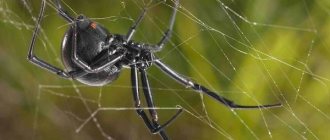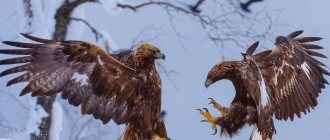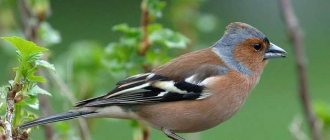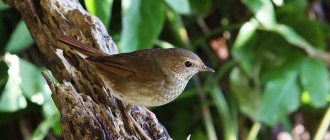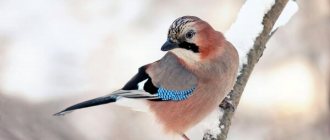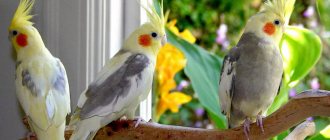Moskovka
The small and lively songbird, the tit, can be easily recognized by its bright lemon-yellow belly with a longitudinal black stripe, black head plumage with white cheeks and bluish-gray back and wings.
These birds have a small, neat beak, flattened on the sides, and very tenacious claws on their paws. As for size, on average tits are slightly larger than sparrows and differ from them in having a longer tail. Their body length reaches 15-20 cm, their weight ranges from 14 to 20 g, and their wingspan is up to 26 cm.
These songbirds belong to the order Passeriformes, the tit family and the genus Tit. At different times, scientists classified various birds as tits, for example, blue tits. However, now this genus includes 4 main species (great tit, gray, eastern, green-backed) and their subspecies.
Tits are not migratory birds. But, as a rule, during the winter cold they try to find more favorable conditions for themselves. They often move to live closer to people.
Just like the bunting bird, the great tit has yellow-black plumage and small size, although representatives of this species are considered the largest: they reach 16 cm in length. The bird is active, cheerful and friendly towards people, so you can watch it from a very close distance if you pour your favorite treat into the feeder.
He has excellent improvisational singing skills. It is fascinating, which is why many representatives are good teachers for canaries. The black tit, as it is also called, is very small, its head is black, and the shirtfront on its chest is the same color. White cheeks, a spot on the back of the head and stripes on the wings attract attention.
The tit is perhaps familiar to each of us, because this bird comes into view more often than many others. Fragile little playful birds jumping from branch to branch - this is exactly how most people imagine a titmouse. However, few people realize that there are a huge number of species of these birds and, seeing many other beautiful birds around us, we do not even suspect that they are also titmouses.
- The tit family, in general, boasts about 65 species of small birds, the mass of which usually does not exceed 25 g, and the body length is most often 150 mm
- This bird lives not only in our latitudes, it is also common in almost all corners of our world
- The most common types of tits include the following: great tit, hanging tit, whiskered tit, tufted tit, blue tit, coal tit, powder tit, Apollo tit.
Now let's talk in more detail about each of the above species of this family.
- Let's start, perhaps, with the great tit, also known as the great tit or grasshopper. This type of titmouse is very beautiful. The back of this bird is light green with yellow tints, the belly is yellow. This bird's distinctive black feature is a black stripe that runs along its belly and chest. The upper part of the head, the sides of the neck, and the neck of this titmouse are painted black, which gives off a bluish sheen in the sun. The sides of the titmouse's head are white. The wings of the large fish are gray, sometimes with a blue tint, and the tail is black.
Great tit
- Hanging tit. The hanging titmouse is the smallest representative of the tit family, because its wing length reaches only 45-55 mm.
- Unfortunately, this tit cannot boast of its color. The bird's body is colored yellowish-gray, giving off greenish in places; overall, this color looks very inconspicuous and inconspicuous.
- Most often this bird can be seen in South-West or South Africa.
- Whiskered tit. Very often, whiskered tits can be found under the name of bearded tit or bearded tit, and all because the adult male of this species has a white throat and a black “beard”. The plumage of these birds has a very beautiful color of light brown, in places with a yellowish tint. The head of the mustachioed tit is colored gray with a blue tint. A distinctive feature of the tail color of these birds (males) is that the tail feathers below are white.
- The female tit does not have a “beard”; its head is colored a warm brown-beige color. The tail feathers below are not white, but beige, milky. Young immature whiskered tits have a color that is close in color to warm beige and yellow.
Whiskered Tit
- Tufted tit. The tufted tit, or as it is also called the grenadier, is a beautiful and interesting bird. A distinctive feature is its crest, which is impossible not to notice even from a distance. It is not difficult to guess that this bird received its name precisely because of the presence of this crest. The entire back of the grenadier is painted in a grayish, brownish color. The crest is colored with small black and white spots, the throat and sides of the neck have black spots. The belly of the tufted tit is white with a yellow tint.
Tufted tit
- Blue tit. Here we come to the description of the most beautiful bird of the tit family. The blue tit has a very unusual bright color, which definitely sets it apart from other birds. The blue tit is a small bird whose plumage is bright blue and yellow. The tit's beak and tail are relatively small; the blue tit itself reaches a length of 10-12 cm. The dorsal part of the tit is colored greenish, but the shade may differ depending on the bird's habitat. The bird's belly is light green with a yellow tint. The blue tit has an azure-colored “cap” on its head, two blue stripes on both sides of its beak, and a blue stripe around its neck. The wings and tail of the bird also have a bluish-blue color.
Blue tit
- Moskovka. This bird can be found under the name black tit, small tit. This bird is reminiscent of a large bird in its color, however, it is significantly smaller in size. The “cap” on the head of the Muscovy is black, the “cheeks” have white spots, the back of the bird is gray with a bluish tint, and the belly and chest are light gray with a light reddish tint. The tail and wings are painted dirty black.
We suggest you read: What vegetables can you give your hamster?
Moskovka
- Puffy. The chickadee is also called the chickadee and marsh tit. This bird does not have a bright, attractive color. The back of the head and the head of this tit are colored black. The back and the entire upper part of the body are distinguished by a light gray color; the abdomen also has a nondescript dirty white color. The wings and tail are most often dark brown.
Puffy
- Apollonovka. The long-tailed tit, also called the Apollo tit, is the smallest bird of all the tits that live in our area. Despite the fact that the Apollo tit is the smallest tit, it boasts a very long and beautiful tail. The head and belly of the long-tailed tit are painted white, the sides of the bird have a barely noticeable pink tint, the wings are most often dark brown or black, and the stepped tail is brown-black.
First, let's talk about whether the titmouse is a migratory bird. In order to understand this issue, you need to understand why some birds fly away at a certain period of time, while others remain in their homeland.
- The first reason why birds fly away to other habitats is the lack of food. For example, most birds that fly away eat insects and other various foods of animal origin. As you understand, in winter it is extremely difficult to find such food, even if it is possible, and in order to survive in the cold, birds need a lot of food
- The second reason is the cold. Here the animal is completely powerless, because it is naturally not able to change the weather
As for tits, most of them are nomadic birds, because with the onset of cold weather they move from the forests closer to humans. In winter, there is very little food in the forest, so birds move to people in the hope of finding something edible and thus ensuring a “well-fed” winter. Tits are not migratory birds, as they are not particularly sensitive to cold.
Tits are nomadic birds.
Now let's talk about the diet of these birds:
- Generally speaking, birds of prey are those that hunt in flight and have a body structure that facilitates this, for example, a sharp beak and large claws. It’s clear that our little titmice don’t fit this description.
- It is more appropriate to classify tits as insectivorous birds, since they most often feed on various larvae, forest pests, beetles, spiders, butterflies, and dragonflies. In winter, he consumes more plant foods, since it is very difficult to find insects at this time.
- It would seem that everything is clear, the tit is an exclusively insectivorous bird, but there is one “but”. Scientists have proven that some species of tits sometimes hunt pipistrelle bats (small bats); as a rule, they hunt them at a time when the mice have not yet fully awakened from hibernation. Having killed its prey, for example, a great tit, pecks out its brain
Tits most often appear to us as active, fast, restless birds, and this is what they really are.
- The hanging titmouse is a very quiet bird that always behaves neatly and silently. Despite this, she is very dexterous in her movements: she can very quickly and quietly inspect tree branches and flowers, in which she looks for bugs for food.
- The long-tailed tit is very sociable and is rarely very afraid of people, so very often you can find such a bird living in someone’s house. Apollonovka differs from many other birds in that it can sing very beautifully. That is why poultry farmers who want to teach other birds to sing take the long-tailed tit as a teacher.
Titmouse
- Blue tits are frisky, active birds that love to jump from branch to branch, while hanging from the branch upside down from time to time. This titmouse is not very afraid of people, so it can often be seen near residential buildings. By nature, the blue tit is not a very good flyer, but uses its legs to move very quickly. This bird can also be called curious, as it loves to “stick its nose” into any crack or hole in the tree.
- The great tit is a very fast, mobile bird. Loves to jump on branches, hanging upside down from them. The great tit flies well, but in order to fly, it flaps its wings frequently. Most often, such a bird can be seen in a flock with other tits.
- The Muscovite is a restless bird that will never sit in one place for a long time. The titmouse flies quickly and well, and while searching for food it also hangs upside down by branches.
- The tufted tit also boasts of its activity and restlessness. Most often it can be seen in the crown of trees, where the bird hides from prying eyes.
Description of the bird
A small and lively songbird is the tit, which can be easily recognized by its bright lemon-yellow belly with a longitudinal black stripe, black head plumage with white cheeks and bluish-gray back and wings. These birds have a small, neat beak, flattened on the sides, and very tenacious claws on the paws.
— Advertising —
As for size, on average tits are slightly larger than sparrows and differ from them in having a longer tail. Their body length reaches 15-20 cm, their weight ranges from 14 to 20 g, and their wingspan is up to 26 cm.
These songbirds belong to the order Passeriformes, the tit family and the genus Tit. At different times, scientists classified various birds as tits, for example, blue tits. However, now this genus includes 4 main species (great tit, gray, eastern, green-backed) and their subspecies.
What does it eat?
Tits are unpretentious in nutrition, which is a plus for keeping them at home. But their diet is seasonal.
In summer, during the nesting and breeding period, tits feed mainly on animal food: small insects and their larvae (beetles, flies, midges, mosquitoes, bedbugs, spiders, aphids). At the same time, birds eat many forest pests, picking them out from under the bark of trees, for which they are often called forest orderlies.
But in the autumn-winter period, titmouses willingly eat grain plant foods and various plant seeds (spruce, pine, birch, linden, rowan, elderberry). This is why tits in cities become frequent visitors to feeders. By the way, in cold winters birds need complementary feeding, since most of the population dies from hunger.
Features of character and lifestyle
Photo: Tit in Russia
Representatives of the tit family are very active animals. They are constantly on the move. They lead a social lifestyle, gathering in large flocks. One such flock can number about fifty individuals. Moreover, such flocks may also include birds of other species. For example, nuthatches. Birds split into pairs only during the mating season. At this time, the animals divide the feeding territory among themselves. About fifty meters are allocated for one couple.
Flying is not the titmouse's strong point. They are not hardy. However, this does not interfere with the life of the birds. In most cases, the animal's route consists of several trees and courtyards. The titmouse moves from one fence to another, from tree to tree. During the flight, the animal manages to profit by catching flying insects.
Tits are not migratory, but in most cases nomadic birds. With the onset of frost, they move closer to people's homes. However, sometimes migration is quite significant. Cases have been recorded when individuals ringed in Moscow were found in Europe. During daylight hours, tits look for food not only on trees and feeders. They often visit people's houses, flying onto balconies and loggias.
The character of titmouses is very cheerful, calm, and perky. They rarely get into trouble with other birds and animals. Tits are not embarrassed by the company of people. You can even feed them by hand. These animals can show aggression only during the period of feeding their offspring. They are quite angry and easily come into conflict with competitors, driving them out of their territory.
Where does the tit live and nest?
As it was said earlier, the tit mainly lives in forests and forest belts, because it is in such an area that it can feel safe and without problems find food for itself in a favorable period of time.
There is another reason why the tit lives for a certain period of time in the forest - the need to reproduce.
- Tits nest in early spring, at this time it is still quite cold and chilly, so their nests should be as warm and comfortable as possible for future chicks. These birds can also nest in mid-summer.
- These birds most often make nests in tree hollows; it is much less common to see a tit’s nest directly between the branches of a tree, in any shelters, crevices, holes in buildings at a height of 3-6 m.
- As a rule, nests are made of wool and all kinds of feathers; twigs, fluff and moss are also used, and if you are lucky enough to find them, then cotton wool.
The most common species, the great tit, can be found throughout Eurasia and even in northwestern Africa. Other species live in smaller ranges - in certain Asian countries.
Tits like to settle on the edges of deciduous forests or near clearings and other open places. In addition, the birds are not at all afraid of people and willingly live in gardens and city parks.
We suggest you familiarize yourself with: The best breeds of meat ducks
Types of tits
In the database of the International Union of Ornithologists, 4 species of great gray tit are noted. These include:
- The gray tit belongs to a species that consists of several subspecies, which until recently represented the species of great tit.
- The great tit (Bolshak) is the largest and most common species.
- The Japanese tit (Eastern) also includes several subspecies, which differ in that they do not have frequent mixing of subspecies.
- Green-backed tit.
Until recently, the Eastern (Japanese) tit was considered one of the subspecies of the great tit, but through the efforts of some scientists it was possible to prove that these are two separate independent species.
TITMS, SIX SPECIES.
Keeping at home
There are no problems keeping tits at home. For the birds, select a spacious cage (45 cm by 30 cm by 40 cm) or an aviary. It is better not to house them with other species, especially if breeding birds is intended.
Cage requirements
The cage should not be placed in bright sunlight or drafts.
Tits will need two drinking bowls - one for drinking, and the second for bathing. These birds simply love water treatments. They also quickly get used to their owner’s hands; they can even be hand-fed.
What to feed
As in nature, tits at home need mixed food. An excellent basis for the diet can be a mixture of white crackers, carrots and chicken eggs, as well as various grain mixtures. A real treat for tits are mealworms. They should be added to food especially often during the nesting period.
By the way, if you let a titmouse out of its cage, it will definitely try to find food for itself - be it gingerbread or cookies.
Social structure and reproduction
Photo: Tit Birds
The nesting period for tits falls in early spring. In most areas of the natural range, it is quite cold in early spring, so birds insulate their nests so that future chicks do not freeze in them. Tits build a nest in pairs, then together they raise their offspring. Animals build nests in sparse forests, gardens, and parks. A large number of nests are found on river banks. Birds place their home at a height of two meters from the ground. They often occupy houses abandoned by other bird species.
During the mating season, tits turn into aggressive creatures. They deftly drive strangers away from their territory, protecting the nest. Animals build a nest from various twigs, grass, moss, and roots. The inside of the house is lined with wool, cobwebs, and cotton wool. At one time, the female can lay up to fifteen eggs. They are white and a little shiny. The surface of the eggs is covered with small brown spots. The bird lays eggs twice a year.
The eggs mature within thirteen days. The female incubates the eggs. The male at this time obtains food for his mate. After hatching, the female does not immediately leave the chicks. During the first days, the chicks are covered with only a small amount of fluff. The mother is engaged in warming her young. At this time, the male begins to get food for the whole family.
Newly born tits are extremely voracious, just like adult birds. Parents have to feed them about forty times an hour.
Chicks become independent only seventeen days after birth. However, they do not immediately leave their parents. For about nine days, young titmice try to stay close. Ten months after birth, the young reach sexual maturity.
What does a titmouse eat in the wild in summer and winter?
- There are two versions about the origin of the name of the genus “tit”. The first indicates the blue color, which is characteristic of blue tits, blue songbirds that formerly also belonged to the tit genus. And the second option attributes the name of the genus to the nature of the song of these birds, in which one can hear the drawn-out “siiii-siiii.”
- Tits never make their own reserves for the winter, but they very easily find and eat food reserves made by other birds;
- Usually affable and friendly tits during the period of nesting and hatching eggs become quite aggressive and drive strangers away from their territory;
- It’s not for nothing that tits are called forest orderlies, as one pair of tits protects at least 40 trees from pests during the nesting period.
- In nature, tits live 1-3 years, and in captivity they can even live up to 15 years.
- The tit is very voracious - it eats almost continuously throughout the day, even if it is not hungry: it still hunts in order to hide its prey, and then, when it gets hungry, to eat it. The tit stores its supplies in a secluded place - a hollow, a crevice. – wide range of feeding area.
It even feeds on insects such as silkworm caterpillars and hawthorns, while most birds do not eat these insects as food. - Thus, the first information about the tit is found in the first legislative act on the protection of birds, where, in addition to it, the list of useful inhabitants of the sky includes also starlings.
What do titmouses eat?
Do they breed in captivity?
If a pair of tits get along in the same enclosure, then over time the birds can begin nesting, for which they need to leave building material - twigs, blades of grass, moss. In one clutch in nature, a female tit can have up to 15 eggs. In captivity, as a rule, less. The female incubates the eggs for 13 days, and then the chicks grow up for about 3 weeks. All this time the male takes care of his wife and offspring.
Does the tit benefit humans?
Many people do not attach much importance to these birds, because all their work is not particularly visible to us humans with the naked eye. Despite this, the benefits of tits are colossal, because these small nimble birds are real pest fighters and their larvae.
- Just imagine, this inconspicuous bird can fly out of the nest about 300 times in 1 day in order to find food for itself and its chicks
- A gray flycatcher can fly out of its nest 500 times
- During these 300-500 flights, the bird brings about 300-600 different insects to the nest
- Even in a cold winter, the titmouse saves trees and the future harvest, because under the bark of trees it looks for pests and eats them
The tit saves trees even in winter
“Does the tit benefit humans?” - definitely brings and this benefit is very great, so people should also treat birds with respect and, if possible, feed them.
Main varieties
Blue tits live in the countries of Eurasia, on the African continent, and also in North America.
Among the blue tits, the most common are the princeling (white blue tit) and a hybrid of the common and white species - the Pleske blue tit, which lives in the Urals.
The white variety deserves special attention. This bird is characterized by a soft blue color of plumage in the area of the wings, tail and back, transitioning to white on the belly and head. The size of the princelings does not exceed the dimensions of a sparrow. The bird weighs only 10 grams.
The prince lives in Belarus, as well as in the Far East. In Asian countries, birds are more common than in other regions. As for our country, the population of blue tits here is extremely small and is listed in the Red Book.
Interesting facts about titmice: examples
Despite the fact that titmice live very close to people, we know very little, if not nothing, about them. Therefore, we invite you to familiarize yourself with the most interesting facts about these birds.
- Tits have long been considered incredibly useful birds for humans, so even in Rus' a decree was issued stating that for the extermination of tits, a person will face severe punishment in the form of a fine.
- Despite the fact that in our area the most common is only 1 species of tit, the great tit, there are about 65 species in nature.
- Many people think that the bird got its name because of the blue color of its plumage, but tits rarely have this color in color and this is surprising. However, in fact, the titmouse got its name because of the sounds it makes; if you listen closely, you can hear “si-sin-si,” hence the tit
Tits: interesting facts
- During the period of feeding the chicks, the tit gives them food about 35 times per hour
- Most tits are excellent flyers, despite the fact that they flap their wings very rarely, they fly very quickly and briskly
- Tits are very sociable birds and can be tamed if desired.
- Almost all tits build nests in hollowed-out hollows, since they themselves do not know how to do this
Tits are incredibly beautiful and useful birds for humans and nature, which is why we must make every effort to ensure that they are comfortable in the winter and that they are not hungry.
Characteristics and behavior of tits: description for children
Tits most often appear to us as active, fast, restless birds, and this is what they really are.
- The hanging titmouse is a very quiet bird that always behaves neatly and silently. Despite this, she is very dexterous in her movements: she can very quickly and quietly inspect tree branches and flowers, in which she looks for bugs for food.
- The long-tailed tit is very sociable and is rarely very afraid of people, so very often you can find such a bird living in someone’s house. Apollonovka differs from many other birds in that it can sing very beautifully. That is why poultry farmers who want to teach other birds to sing take the long-tailed tit as a teacher.
Titmouse
- Blue tits are frisky, active birds that love to jump from branch to branch, while hanging from the branch upside down from time to time. This titmouse is not very afraid of people, so it can often be seen near residential buildings. By nature, the blue tit is not a very good flyer, but uses its legs to move very quickly. This bird can also be called curious, as it loves to “stick its nose” into any crack or hole in the tree.
- The great tit is a very fast, mobile bird. Loves to jump on branches, hanging upside down from them. The great tit flies well, but in order to fly, it flaps its wings frequently. Most often, such a bird can be seen in a flock with other tits.
- The Muscovite is a restless bird that will never sit in one place for a long time. The titmouse flies quickly and well, and while searching for food it also hangs upside down by branches.
- The tufted tit also boasts of its activity and restlessness. Most often it can be seen in the crown of trees, where the bird hides from prying eyes.
As you can see, all titmice are very mobile and active birds, which rarely just sit on tree branches.
Tit: a bird of prey, a migratory bird or not?
First, let's talk about whether the titmouse is a migratory bird. In order to understand this issue, you need to understand why some birds fly away at a certain period of time, while others remain in their homeland.
- The first reason why birds fly away to other habitats is the lack of food. For example, most birds that fly away eat insects and other various foods of animal origin. As you understand, in winter it is extremely difficult to find such food, even if it is possible, and in order to survive in the cold, birds need a lot of food
- The second reason is the cold. Here the animal is completely powerless, because it is naturally not able to change the weather
As for tits, most of them are nomadic birds, because with the onset of cold weather they move from the forests closer to humans. In winter, there is very little food in the forest, so birds move to people in the hope of finding something edible and thus ensuring a “well-fed” winter. Tits are not migratory birds, as they are not particularly sensitive to cold.
Tits are nomadic birds
Now let's talk about the nutrition of these birds:
- Generally speaking, birds of prey are those that hunt in flight and have a body structure that facilitates this, for example, a sharp beak and large claws. It’s clear that our little titmice don’t fit this description.
- It is more appropriate to classify tits as insectivorous birds, since they most often feed on various larvae, forest pests, beetles, spiders, butterflies, and dragonflies. In winter, he consumes more plant foods, since it is very difficult to find insects at this time.
- It would seem that everything is clear, the tit is an exclusively insectivorous bird, but there is one “but”. Scientists have proven that some species of tits sometimes hunt pipistrelle bats (small bats); as a rule, they hunt them at a time when the mice have not yet fully awakened from hibernation. Having killed its prey, for example, a great tit, pecks out its brain
Nutrition Basics
The diet of the common blue tit is varied, like that of any omnivorous bird. But, about 80% of all food consumed by birds is food of animal origin. Depending on the selected nesting territories, it feeds on:
- flies;
- larvae;
- dragonflies;
- aphids;
- mosquitoes;
- caterpillars;
- berries;
- seeds and grains;
- human food waste.
The blue tit is a good helper for agriculture and forestry, as it destroys harmful insects. At the same time, the bird itself, unlike sparrows and other representatives of the passerine order, does not engage in pest activity and does not destroy agricultural crops.
In winter, when insects disappear, birds survive on plant food. They feed on seeds of coniferous and deciduous trees. In the hungry months, a person comes to the aid of the bird. By feeding from feeders, blue tits have every chance of surviving until spring.
